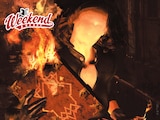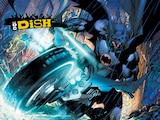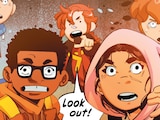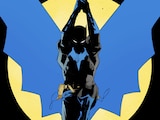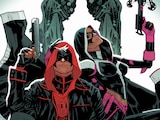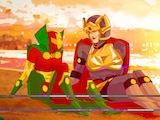DC Ink’s second book Under the Moon: A Catwoman Tale stars, arguably, one of the most iconic DC characters from one of the most iconic families. The Bat-Family has dominated the pages of DC’s comic books for as long as the company has existed—since before the company was even called “DC Comics” for the very title Batman and Catwoman were introduced in, Detective Comics—so it makes sense Selina Kyle would enjoy a high profile.
The Bat-Family truly earns its name as one of the running themes in Batman’s comic book pantheon is that of family, particularly found families. Bruce Wayne lost his parents at an early age and found Alfred. When Dick Grayson in turn lost his parents during a similar tragedy, Bruce brought him into the unconventional Wayne family and made him Robin. This same trend was repeated with Jason Todd and Tim Drake, the next two Robins who emerged over Batman’s 80 years of history, along with more recent characters like Cassandra Cain, Stephanie Brown and Duke Thomas.
It’s often forgotten, but Selina is another character who shares this same narrative. In all of her origins, she comes from a broken, troubled home. While Lauren Myracle and Isaac Goodhart’s Under the Moon: A Catwoman Tale offers a new, Young Adult-skewing take on Catwoman’s origin, Myracle maintains Selina’s abusive upbringing. However, while other Catwoman tales have shown Selina growing up on the streets along, Under the Moon gives her a family…of sorts.

It all starts out a little bit unconventional with the stray kitten Cinders coming into Selina’s life almost as a surrogate sister. There are some pretty obvious overtones in having Selina come across a scruffy kitten in distress. Sure, it’s a nod that she’s destined to become Catwoman—or Catgirl, as she’s called in Under the Moon—but while Cinders helps to create a tiny family for Selina to look after, she is also an allegory. Cinders is small, scared and needs to be taken care of, something that Selina herself can relate to. Compared to the monstrous, abusive Dernell, Selina is small, she’s scared, and she really needs her mom to step up and give some thought to her well-being, which sadly, never happens. When Selina’s best efforts to protect the vulnerable Cinders fail, it serves as the impetus to get Selina out of her family home and into the arms of a found family who appreciate her the way her so-called real family never have.
What happens to Cinders also explores how Selina views herself at the beginning of Under the Moon: A Catwoman Tale. By the end of the graphic novel, she’s very nearly an adult with a real sense of herself and where she thinks her place in the world is. It’s a far cry from squatting in strangers’ tool sheds and scrounging for her next meal.
Selina’s surrogate family is a crew of fellow runaways who have no problems with stealing from those who can afford it. It’s clearly where Catwoman’s eventual philosophy stems from, but the great thing about Selina’s found family in Under the Moon is that they don’t only impact and change her—she impacts and changes them as well.

Amongst their ranks is a young girl named Briar Rose. Despite being named after a classic princess, “Rosie” (as Selina takes to calling her), is anything but delicate. In many ways, she’s who Selina would have been if she had been forced out at a much younger age than she was. Rosie has a lot of the same qualities as Selina, but she’s more closed off. This is really saying something because this Selina Kyle is a pretty closed off person! We see this illustrated (pun totally intended!) over and over again throughout the course of Under the Moon via her interactions with Bruce Wayne.
It takes seeing the world through Rosie’s eyes, witnessing everything that has happened to her, and observing how it has affected Rosie for Selina to appreciate the limited, unconventional support system she does build throughout the graphic novel.
Slight spoiler for the end of the book, so if you haven’t read Under the Moon: A Catwoman Tale yet, proceed at your own risk!!

By the end of the graphic novel, Selina has not only learned to trust and rely on her found family and see the value in having a group of people that have your back, she also learns that sometimes people grow apart. Sometimes people do leave and it’s not the end of the world. I was pretty surprised when Rosie left Selina and her band of misfit toys. Honestly, I expected Rosie to bring her brother to join their ranks and live in their super cool Batcave (complete with super unsafe space heaters!) and was surprised when she ultimately left Selina and their family behind. However, that’s the way life goes sometimes. People grow apart, things change and it’s not always a bad thing. This is a pretty remarkable lesson hiding among all the drama, action and heists of Under the Moon and something I commend the graphic novel for addressing.
Non-traditional, less-nuclear families exist in the world and they are important. I was surprised to find this heartfelt message wrapped in a vigilante story, wrapped in awesome art with a slick color pallet, with Batman as a supporting character. But maybe I shouldn’t have been. After all, it’s a Gotham City tradition.
Under the Moon: A Catwoman Tale by Lauren Myracle and Isaac Goodhart is now available in bookstores, comic shops and as a digital graphic novel.
When not expressing her love for Robin and the Teen Titans, Ashley V. Robinson can be found writing about TV here on DCComics.com as part of the Couch Club and giving Geek History Lessons on the Jawiin YouTube channel. You can follow her on Twitter at @AshleyVRobinson.


